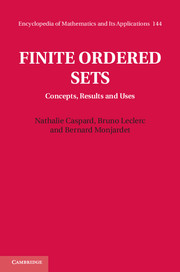Book contents
- Frontmatter
- Contents
- Preface
- 1 Concepts and examples
- 2 Particular classes of ordered sets
- 3 Morphisms of ordered sets
- 4 Chains and antichains
- 5 Ordered sets and distributive lattices
- 6 Order codings and dimensions
- 7 Some uses
- A About algorithmic complexity
- B The 58 types of connected ordered sets of size at most 5
- C The numbers of ordered sets and of types of ordered sets
- D Documentation marks
- References
- List of symbols
- Index
A - About algorithmic complexity
Published online by Cambridge University Press: 05 February 2012
- Frontmatter
- Contents
- Preface
- 1 Concepts and examples
- 2 Particular classes of ordered sets
- 3 Morphisms of ordered sets
- 4 Chains and antichains
- 5 Ordered sets and distributive lattices
- 6 Order codings and dimensions
- 7 Some uses
- A About algorithmic complexity
- B The 58 types of connected ordered sets of size at most 5
- C The numbers of ordered sets and of types of ordered sets
- D Documentation marks
- References
- List of symbols
- Index
Summary
Using the notions and results presented in this book requires answering some questions about an ordered set modeling such situations. It may, for instance, be about determining a linear extension of the ordered set, or the lattice of its downsets, or its covering graph, or computing its width or its dimension.
The effective resolution of these problems requires the use of an “efficient algorithm” implemented by a program to be run on a computer. But given a problem, is there a solving algorithm and, if so, is it efficient and how could we measure this efficiency? We consider a two-level study of that type of question.
On the one hand there is the computational complexity theory which, from a formalization of the notions of a problem and an algorithm (for example by means of “languages accepted” by a “Turing machine”), leads to a problem classification with respect to the difficulty of solving them algorithmically – and independently of the algorithm used. The aim of the first part of this appendix is briefly to provide an intuitive idea on this classification.
On the other hand, for a given problem, we will search for the most efficient algorithms (or heuristics), taking into account the numerous factors which in practice may improve their efficiency.
In the second part of this appendix, we will give a list of problems on ordered sets with, for each of them, the mention of the complexity of at least one resolution algorithm (but not necessarily of the “best” algorithm) and associated references.
Information
- Type
- Chapter
- Information
- Finite Ordered SetsConcepts, Results and Uses, pp. 270 - 285Publisher: Cambridge University PressPrint publication year: 2012
